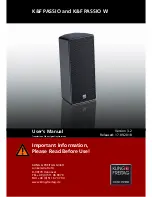
DD12
User Guide V1.0
17
DD12
USER GUIDE
CONNECTIONS
MAINS
The DD12 may be powered by most AC mains voltages found throughout the world. It is fitted
with a Neutrik® PowerCON TRUE1 single phase mains inlet. If you are not using a Martin
Audio power distribution cable system, a mating Neutrik® PowerCON TRUE1 (NAC3FX) outlet
connector must be used. For outdoor use all mains power connectors should be rated to IP65.
See “Safety Information” on page 2 for electrical safety details.
AUDIO INPUT AND LINK
Analogue inputs should be connected with a good quality 3-pin male XLR wired to good quality
twin screened cable. This is particularly important if the input cable run is long (e.g., from the
FOH position to stage). Good quality cable will minimise losses. The Link outputs should use
a similarly high quality female XLR. The line driver at the signal source must be able to drive
the combined load of all DD12s being linked
.
Wiring is the industry standard for balanced
connections:
PIN
CONNECTION
1
Ground or shield
2
Signal ‘hot’ (‘+’)
3
Signal ‘cold’ (‘-’)
AES/EBU input connections are identical to analogue, but the cable used must be a dedicated
low-capacitance digital audio cable with a characteristic impedance of 110 ohms, such as
Belden 1800F or 1696A. The DD12’s inputs can only be enabled for digital use via the Vu-Net
software application.
For more details of Merlin and U-Net please see the relevant User Guides.
USB
The Type B USB port allows connection of a PC for system control and monitoring purposes. For
simple set-ups using the internal presets, this connector may be ignored.
The USB port may be used for network control purposes in smaller systems in preference to
the U-Net system (see page 18). As USB connectivity generally imposes a 5 m cable length
limit, a Silex USB-to-Ethernet convertor is available from Martin Audio as an optional accessory
(Part No. ASF14103). This is a self-contained, physically small unit which can be attached with
Velcro or similar to the DD12. It connects to the DD12 with a standard USB cable, and back to
the laptop running Vu-Net via Ethernet.
















































